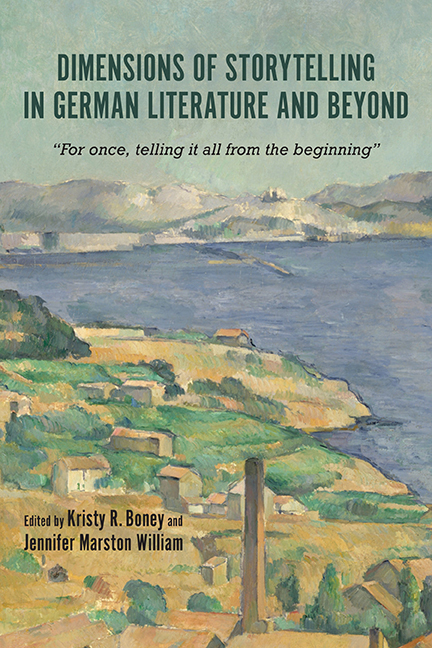 Dimensions of Storytelling in German Literature and Beyond
Dimensions of Storytelling in German Literature and Beyond Book contents
- Frontmatter
- Contents
- Acknowledgments
- Introduction: The Social, Political, and Personal Dimensions of Storytelling
- Part I Anna Seghers: A Missing Piece in the Canon of Modernist Storytellers
- 1 Anna Seghers in Heidelberg: The Formative Years
- 2 Who Is the Narrator? Anna Seghers's “The Excursion of the Dead Girls”: Narrative Mode and Cinematic Depiction
- 3 Anna Seghers's Rubble Literature, 1947–49
- 4 Anna Seghers and the Struggle to Tell Stories about the Nazi Past in the Early German Democratic Republic
- 5 Aufbauzeit or flaue Zeit? Anna Seghers's GDR Novels
- 6 The Time of Decision in Anna Seghers
- 7 Filling the Void with Stories: Anna Seghers's Conceptual Metaphors
- Part II Expressions of Modernity: Using Storytelling Unconventionally
- Part III The Personal Narrative: Storytelling in Acute Historical Moments
- Notes on the Contributors
- Index
7 - Filling the Void with Stories: Anna Seghers's Conceptual Metaphors
from Part I - Anna Seghers: A Missing Piece in the Canon of Modernist Storytellers
Published online by Cambridge University Press: 12 April 2019
- Frontmatter
- Contents
- Acknowledgments
- Introduction: The Social, Political, and Personal Dimensions of Storytelling
- Part I Anna Seghers: A Missing Piece in the Canon of Modernist Storytellers
- 1 Anna Seghers in Heidelberg: The Formative Years
- 2 Who Is the Narrator? Anna Seghers's “The Excursion of the Dead Girls”: Narrative Mode and Cinematic Depiction
- 3 Anna Seghers's Rubble Literature, 1947–49
- 4 Anna Seghers and the Struggle to Tell Stories about the Nazi Past in the Early German Democratic Republic
- 5 Aufbauzeit or flaue Zeit? Anna Seghers's GDR Novels
- 6 The Time of Decision in Anna Seghers
- 7 Filling the Void with Stories: Anna Seghers's Conceptual Metaphors
- Part II Expressions of Modernity: Using Storytelling Unconventionally
- Part III The Personal Narrative: Storytelling in Acute Historical Moments
- Notes on the Contributors
- Index
Summary
Seghers's Prose of Stasis and Motion
THE WORKS OF ANNA SEGHERS are so richly varied, and so numerous, that sweeping generalizations about them prove futile. At the same time, a number of thematic, stylistic, and linguistic patterns emerge quite clearly across her oeuvre. For instance, much of her prose is characterized by a rhythmic quality that parallels the motions of the wind, the sea, the rolling fog, and other natural elements that not only serve as her physical backdrops but also contribute to her “mythic topographies.” Seghers's language often reflects the stasis and motion that her characters experience as they find themselves dealing with frustrating, challenging, and sometimes seemingly hopeless situations. Examples of this contrast of stasis and motion are abundant in Seghers's work, with the degree of movement often changing noticeably from one sentence to the next, as in the opening chapter of Aufstand der Fischer von St. Barbara (Revolt of the Fisherman of Santa Barbara, 1928), with its juxtaposition of verbs that indicate motion or momentary inactivity: gehen/zögern; rennen/gähnen (to go/to hesitate; to run/to yawn). Seghers creates a powerful sense of rhythm and an often lyrical style through a combination of techniques, such as repetition, onomatopoeia, alliteration, assonance, and evocative lexical choices (particularly verbs). Her style is one of simplicity, not overdone or forced. Yet Seghers's writing is by no means apolitical. Her stories often feature humans coping with natural forces such as the wind and the sea but are also very much about humans coping with other humans, struggling to coexist amidst stark ideological difference.
On the whole, despite taking a critical stance toward depicted political events and their ramifications, Seghers's writing conveys a certain— while neither blatant nor naïve—optimism. Although this optimism is grounded partly in a socialist belief in progress, it also marks Seghers's unrelenting belief in humanity. She demonstrated time and again through her stories how seemingly small actions can make a large positive impact. Taking a cognitive-literary approach, in my essay I elaborate how her use of conceptual-metaphorical language skillfully highlights humankind's potential to fill the inherent emptiness of human existence with meaning.
- Type
- Chapter
- Information
- Dimensions of Storytelling in German Literature and Beyond“For once, telling it all from the beginning”, pp. 95 - 108Publisher: Boydell & BrewerPrint publication year: 2018
